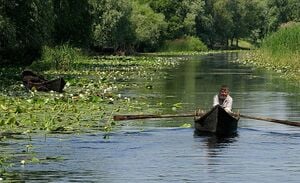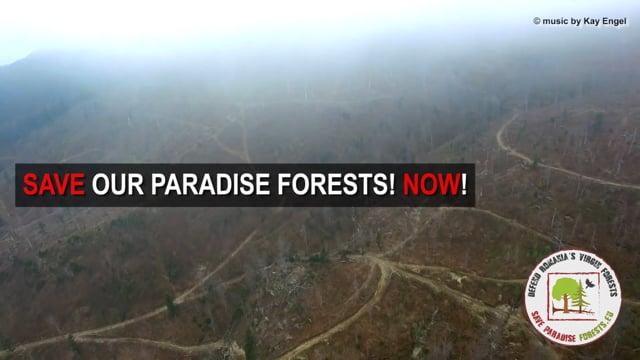Romania community action

 Herd of 170 bison could help store CO2 equivalent of almost 2m cars, researchers say, theguardian.com (May 15, 2024)
Herd of 170 bison could help store CO2 equivalent of almost 2m cars, researchers say, theguardian.com (May 15, 2024)
Biodiversity[edit | edit source]
- Wild Transylvania, "collection of stories documenting the lives of people and wildlife in a remote corner of Romania", added 12:48, 16 March 2021 (UTC)
- Agent Green, nonprofit NGO for environmental protection founded in 2009 for biodiversity conservation.
Rewilding[edit | edit source]
Danube Delta rewilding area[edit | edit source]
The 580,000-hectare Danube Delta is home to massive amounts of water birds, most notably pelicans of two species, herons, storks, cormorants, and terns. It is a favourite staging area for passage migrants and wintering grounds for masses of migrating water birds from the steppes, the boreal forests, and the tundras further north. The region has some of Europe's few remaining grazed mosaic forest landscapes, kept in their natural state by the wild horses and wild cattle still present. Working with partners, the Rewilding Danube Delta team is working to significantly improve the ecological integrity and natural functioning of 40,000 hectares of wetland and terrestrial delta habitat, using rewilding principles on a landscape scale. Revitalised and self-governing natural processes, particularly flooding and natural grazing, will govern landscape formation, driving other natural processes, wildlife comeback, increased biodiversity, and the development of a nature-based economy. The Danube Delta rewilding area is part of the Tauros breeding programme, managed by the Taurus Foundation and Rewilding Europe. The programme aims to breed a cattle breed that resembles the aurochs by establishing viable free-ranging populations of cattle in several European locations. Due to translocations in 2016 and 2017, the number of Tauros cattle grazing near Sfântu Gheorghe, Tulcea is now 18 animals. Rewilding Europe works to create new opportunities for delta communities by supporting the development of nature-based business. 2019 saw the release of a water buffalo herd as a proxy for Bubalus murrensis; and 2020, of a Turkmenian kulan herd (a species present in European Russia until the 18th or 19th century, and close relative of the Western European wild ass that became extinct in the Chalcolithic).
Southern Carpathians rewilding area[edit | edit source]
The Southern Carpathians were considered a good place for nature conservation work. Rewilding Europe has concentrated on part of the region which counts more than 1 million hectares of protected areas already in place, rich wildlife, large intact forests, a high concentration of biodiversity, relatively intact wild landscapes, wild rivers, and large areas of mosaic vegetation largely shaped by traditional farming and grazing practices.
The work of Rewilding Europe and its partners is focused on bringing back the European bison. Since 2013, Rewilding Europe and WWF Romania have been working together in the Southern Carpathians rewilding area to reintroduce this iconic species. The major objective of this ongoing project is to create a demographically and genetically viable population in the Southern Carpathians, comprising free-roaming sub-populations in the Țarcu Mountains and nearby Poiana Ruscă Mountains.
So far, following bison releases in 2014 and 2015, in June 2016, a third bison release took place as part of the European Commission-funded LIFE Bison project, with a fourth release of nine animals taking place in April 2017. Rewilding Europe and WWF Romania have been working together to create one of the largest contiguous wild areas in Europe.
Open spaces[edit | edit source]
wikipedia:Protected areas of Romania
Community energy[edit | edit source]
Wikipedia: Solar power in Romania, Wind power in Romania
Ethical consumerism[edit | edit source]
buynothingday.home.ro (2005)
Social inclusion[edit | edit source]
Sustainable transport activism[edit | edit source]
Wikipedia: Romania, Waterways
Resources[edit | edit source]
Research[edit | edit source]
Associative Environmentality Romanian Forest Commons Project
News and comment[edit | edit source]
2021
- Back from the brink: Bison return to Romania after 200-year absence, Dec 1, 2021...[1]
2017
Rosia Montana: how Romanians united to save a mountain village from mining apocalypse, Jan 11[2]
2016
Rescuing Romania's forest, Oct 28[3]
How nature turned a failed communist plan into Bucharest's unique urban park, Jun 14[4]
2014
People build bridge out of plastic bottles in Romanian city, July 24[5]
European bison to roam the forests of Romania after 200 years, May 21[6]
2009
The PRAIS Foundation, an organization in Romania, in partnership with the Romanian Ministry of Environment and the National Environmental Guard and other partners, have confirmed that they have planted over eleven million trees through the national tree planting movement 'Millions of People, Millions of Trees'.
"The PRAIS Foundation is very proud that the movement is formally recognized by UNEP, and has become part of the Plant for Planet global initiative", Silvia Bucur, the President of the PRAIS Foundation.[7] March 30
Campaigns[edit | edit source]
About Romania[edit | edit source]
Romania is a country located at the crossroads of Central, Eastern and Southeast Europe. It borders Ukraine to the north and east, Hungary to the west, Serbia to the southwest, Bulgaria to the south, Moldova to the east, and the Black Sea to the southeast. It has a mainly continental climate, and an area of 238,397 km2 (92,046 sq mi) with a population of 19 million people. Romania is the twelfth-largest country in Europe and the sixth-most populous member state of the European Union. Europe's second-longest river, the Danube, empties into the Danube Delta in the southeast of the country. The Carpathian Mountains cross Romania from the north to the southwest and include Moldoveanu Peak, at an altitude of 2,544 m (8,346 ft). Bucharest is the country's largest urban area and economic hub. Other major urban centres include Cluj-Napoca, Timișoara, Iași, Constanța and Brașov.
Settlement in the territory of modern Romania began in the Lower Paleolithic, later becoming the kingdom of Dacia before Roman conquest and Romanisation. The modern Romanian state emerged in 1859 through the union of Moldavia and Wallachia and gained independence from the Ottoman Empire in 1877. During World War I, Romania joined the Allies, and after the war, territories including Transylvania and Bukovina were integrated into Romania. In World War II, Romania initially aligned with the Axis but switched to the Allies in 1944. Following the war and occupation by the Red Army, Romania became a socialist republic and a member of the Warsaw Pact. After the 1989 Revolution, Romania began a transition towards democracy and a market economy.
References

